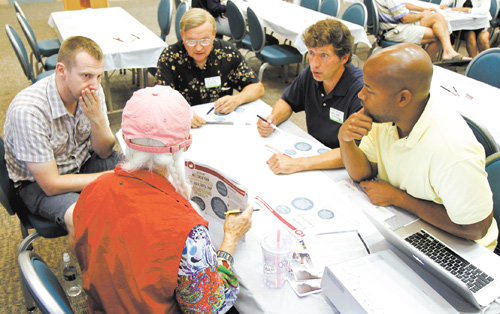Young leaders brainstorm downtown Youngstown

With funding from a $4.2 million grant from the U.S. Department of Housing and Urban Development, 32 regional organizations have come together across Northeast Ohio with an ambitious plan to capitalize on what the region has to offer and improve its future.
YOUNGSTOWN
With funding from a $4.2 million grant from the U.S. Department of Housing and Urban Development, 32 regional organizations have come together across Northeast Ohio with an ambitious plan to capitalize on what the region has to offer and improve its future.
Just one in a series of events by the group, known as the Northeast Ohio Sustainable Community Consortium, took place Tuesday at the Youngstown Historical Center of Industry and Labor in downtown.
In a bid to brainstorm ideas about the economic, environmental, transportation and land-use challenges confronting Youngstown and the broader region, both residents and members of the Young Mahoning Valley Leaders were on hand to keep “a lens on the issues,” said Jeff Anderle, consortium spokesman.
Mostly geared toward a younger demographic, Anderle said his consortium’s initiative is all about developing a comprehensive framework for “best tools and practices,” aimed at better solving problems across northeast Ohio’s 12 counties, which include Mahoning and Trumbull.
He identified the process as complex and challenging, but necessary, for a part of the state that has seen its population dwindle and its economy fall short in recent years.
In all, the consortium is funded through the end of 2013, and by that time, Anderle said the goal will be to provide insightful solutions from working sessions such as those in Youngstown. Those recommendations then will be passed along to community leaders, municipal governments and proprietors so they can make informed decisions as the region grows to confront current and future challenges.
“It’s difficult to get traction in these instances,” Anderle said. “But this is all about giving citizens and officials the tools they need to make things happen. We want to give them a living document to get things off the ground.”
For the most part, the sessions are a way for area youths to generate talking points on what’s working for a place such as Youngstown and what’s not working.
Thus far, the consortium’s efforts have created a conditions-and-trends platform that identifies solid ideas and common grievances.
On Tuesday, about 12 participants were reacting to the findings and offering their perspective on what groups in Youngstown and elsewhere already have discussed.
For instance, Young Mahoning Valley Leaders have identified a need for more young elected officials, greater urban restoration and more rehabilitation programs for addicts and criminals.
“Public transportation is not working for this county,” said Howard Markert of Youngstown, who participated in Tuesday’s session. “There are not enough options, and there aren’t the right kinds.”
But turning talking points into reality often is difficult. For Markert, the session was a way to bring minds together on the issues confronting Youngstown, with the greater goal of engaging the community at large.
“Things like this are an excuse to get people together and get them talking,” added Jacob Harver, who also owns the Lemon Grove, a bar and restaurant in downtown Youngstown. “It’s the people that sustain the local economy, and you have to get them engaged.”
The Young Mahoning Valley Leaders, along with the consortium, will have its next working session in the city sometime in October.
 43
43
